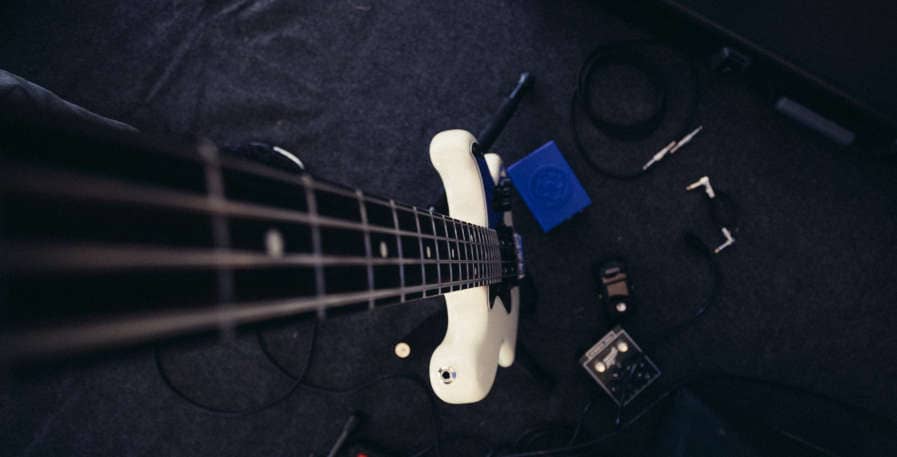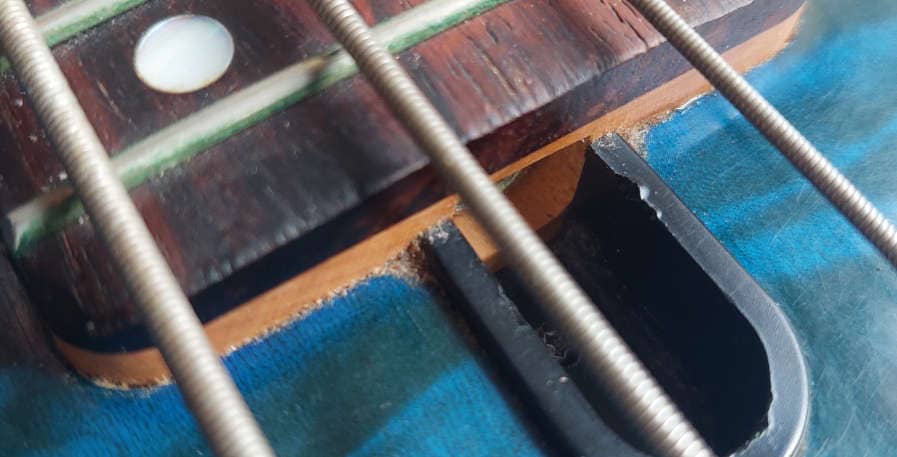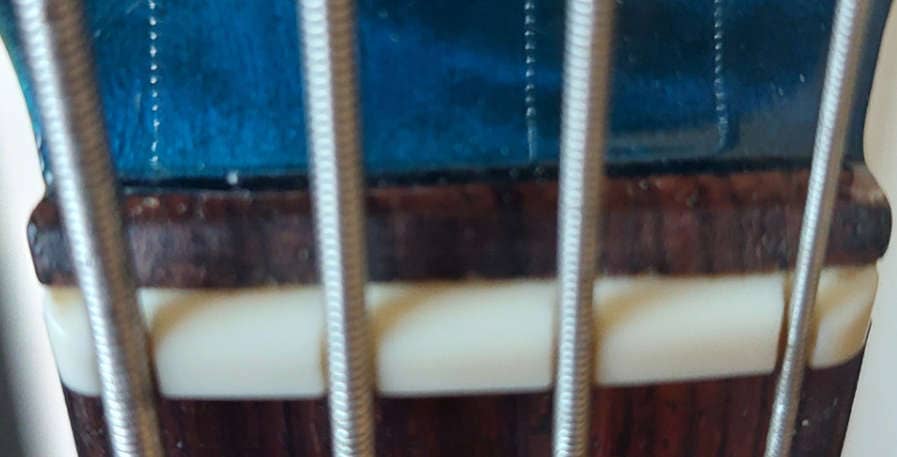This post contains affiliate links
There are few things that are more annoying than having your bass guitar rattle while playing it.
Whether it`s a completely new bass or the issue seemingly happened overnight, it can also be hard to tell what is causing the unwanted noise.
That`s why I`ve written this guide to help you solve this issue in a quick and easy manner.
First I`ll show you the possible reasons why your bass guitar rattles. This will help you diagnose the cause of the issue so that you don`t waste your time on solutions that won`t work.
Then, I`ll show you how to get rid of the rattling sound. Some solutions will take care of multiple causes, while others target specific ones. This way, you will be able to get rid of the rattling sound your bass makes, regardless of what is causing it.
Why does my bass guitar rattle?
While bass rattle often has an easy solution, it can be hard to diagnose the cause of it. This is because there are many things that cause the noise and it`s not always easy to tell where it’s coming from.
Below are 8 reasons you could be hearing a rattling noise while playing your bass. As you read them, I recommend inspecting your bass to see which ones could apply to you.
1. Low action
Action refers to the space between the strings and frets on your bass. Low action means there is little space between them and high action means there is a lot of space.
While most bassists prefer low action, setting it too low will cause string rattle and fret buzz. This is because your strings will not have enough space to vibrate. As a result, they will be hitting other frets when you pluck them.
2. Unsuitable break angle
The height of the nut on your bass will influence the playability and resonance of its strings. “Break angle” refers to the angle at which the strings slide down from the nut and unto the tuning pegs.
If the break angle isn’t steep enough, the strings will not be situated firmly enough. This can cause them to rattle. This is a result of the nut being too uneven or low, or that the cuts in the nut are too deep for your current set of strings.
3. Neck tension
If the neck of your bass is too tense, it can cause intonation issues and an uneven action across the neck. This unevenness can also cause certain parts of the fretboard to cause a rattling sound while other parts won`t.
Thus, if you are only hearing a rattle when playing at certain spots on the neck, this could be caused by neck tension. This is especially likely to be the cause of the issue if the rattling only occurs when playing halfway up the neck.
4. Loose parts
If the rattle is not coming from your strings, it could be caused by other parts on your bass being loose.
Parts that could have a loose part include the pickups, the bridge, or the machine heads. This will be extra noticeable when playing as the vibration of the strings will make the loose part rumble. You might also notice a slight rattle when moving your bass.
5. Defective truss rod
The truss rod sits inside the neck of the bass and stabilizes it. A truss rod is necessary because the strings exert tension on the neck of the bass which needs to be balanced out.
If the truss rod is defective and not stabilizing the neck properly, this can cause a multitude of issues. One of these is that it can cause a rattling sound, as both the action and neck tension will be affected.
6. Loose strap lock
Strap locks are used to secure the strap on your bass so it doesn`t loosen when you play it.
Depending on the strap lock and how you move when playing the bass, it could be the cause of the rattling sound. This generally happens because the locking mechanism on the strap lock is not secured tightly enough. Thinner straps are harder to secure tightly, which can further increase the chance of the lock causing a rattle.
7. Worn out strings
Another possible cause of string rattle is that one or more strings have started breaking.
While bass strings can be reused and rejuvenated most of the time, rattling could be a sign that they need to be replaced. While rare, this happens when parts of the outer wiring start to loosen from the core of the string.
8. Aggressive plucking
One often-overlooked reason for bass rattle is that the strings are being picked too hard.
Aggressive picking is not inherently bad though. Among others, bassists such as Geddy Lee pick the strings with force to produce an attack-heavy tone. However, a bass that is not properly set up for this can produce an unwanted rattling sound.
Picking style is especially likely to be the cause of the issue if you have just gotten a new bass, or if you are completely new to playing bass.

How do I stop my bass guitar from rattling?
The reasons listed above can be used to diagnose the cause of the rattle. Depending on the cause, this could be enough to fix the issue. If not, follow the appropriate steps below to stop your bass from rattling. Feel free to skip over any steps that you know are not relevant to you.
Get the bass set up
Solves: All of the most common causes of bass rattle
Regardless of what is causing your bass to rattle, a setup should remove the issue. A proper setup ensures that the playability and sound of your bass are set correctly. Thus, you can expect the rattle to disappear, as most of the possible causes of it will be fixed.
The downside is that it will either cost you money or be the solution that takes the most amount of work.
You can choose to set up the bass on your own or pay a luthier to set it up for you. The advantage of a luthier doing it is that you can tell them that you are specifically getting the setup to remove the rattling. This way they will be able to diagnose the cause of it, and ensure that it does not persist.
If you are not replacing your strings, the average cost of a bass setup is $63.18. With the cost of new strings added, the average cost is $79.54.
Adjust the truss rod
Solves: Neck tension and low action
A truss rod adjustment is part of a bass setup. However, if you found that the rattle was caused by low action or due to neck tension, a truss rod adjustment will generally be sufficient to solve the issue.
Depending on your bass, the screw that turns the truss rod is located either right above the fretboard on the headstock, or right below it where the fretboard and body meet. It is commonly protected by a small cave-in.

The screw can be adjusted with a hex key/Allen wrench. Turning the key clockwise will tighten the truss rod and turning it counterclockwise will loosen it.
It is a best practice to only turn it a quarter of a turn at a time, and never more than half a turn. Inspect your instrument the following day and turn it again if necessary.
Note: On some basses, the neck has to be removed in order to adjust the truss rod. If are unfamiliar with adjusting the truss rod and can not find a cave-in with a screw on your bass, I recommend seeking the help of a luthier.
If you are increasing the action in addition to the neck relief, the strings also need to be raised at the bridge saddle. This is the metal part where your strings are seated at the bottom of the bass.
Depending on the instrument, individual strings can be adjusted one at a time, or the whole saddle needs to be adjusted in one go. Typically it can be adjusted with a small Allen wrenchm and you need to turn the key clockwise to raise the action.
Adjust the break angle
Solves: Break angle
The first thing to do is inspect whether the strings are firmly situated in the nut. If the strings barely have a break angle, meaning they don’t bend at the nut, this could be caused by insufficient wrapping around the tuning pegs. As a general rule, aim for at least 2-3 wraps around the tuning pegs.
Related reading: How Many Times Should Bass Strings Wrap Around Tuning Pegs
If the strings have too much space in the nut, it has been cut too deep for your current set of strings. In this case, you need a heavier set of strings to accommodate the nut, or simply buy a new nut that fits them.

The latter is generally preferable, as a string change will alter your tone and might not suit the tuning you are looking to play in. Nuts are available on Amazon, are affordable, and are relatively easy to mount.
If you get a new nut, make sure to measure the width of your current one first. The vast majority of 4-string basses either have a nut that is 42mm (1.65″) or 38mm (1.49″). It needs to be the same width as your current one to properly fit the bass.
Secure loose parts
Solves: Loose strap lock or other loose parts
If you found that your bass rattles because of a loose part, it can generally be screwed tight to remove the noise.
Listen closely to where the rattle is coming from, and pay attention to any moving parts. The vast majority of the time, you are dealing with a component that can be resecured with a small screwdriver. Pay extra attention to your pickups, and the bridge saddle.
You might also find that the strap lock was the cause of the issue. Strap locks are more prone to rattle if you use a thin strap, so using a thicker strap could solve the issue if tightening it doesn`t work.
If that doesn`t solve it, you will need a different type of strap lock, or remove it altogether. For a non-rattling strap lock, I recommend this one from Dunlop.
Change your picking style
Solves: Aggresive plucking (Will also diminish the rattle if it is caused by something else)
Try plucking the strings on your bass as softly as possible. If the rattle does not persist, it could be caused by you picking the strings with a lot of force.
One solution to this is to pluck softer and rebuild your picking style. If you prefer your current style, either for the comfort or for the tone it produces, the best course of action is to get your bass set up to accommodate it. While this will result in higher action, the tradeoff will generally be worth it.
In addition to the intensity of your plucking, the angle at which you pluck can cause the bass strings to rattle. I mainly play fingerstyle at pluck with my hand at a roughly 90-degree angle to the strings. If your picking hand is slightly bent when playing, I recommend trying a steeper angle to see how this affects the sound.
Switch strings
Solves: Broken strings (Can also solve low action, string tension, and break angle)
If nothing else solves the issue, your strings might just be played out and broken.
In this case, there is nothing else you can do than to get a new set. As long as your current strings fit in the nut, you can use the same gauges you are currently using.
However, if you get a set with thinner string gauges, this could solve the issue if the rattle is caused by low action or a bad break angle. Bear in mind that switching to a lighter set will affect your tone, lead to a thinner sound, and feel different to play.
Conclusion
Luckily, bass guitar rattle doesn`t have to be a lasting issue. The noise can be removed in most cases using the steps above. If all else fails, a setup will take care of it. Chances are that if the strings are rattling, the bass can greatly benefit from being set up for various other reasons as well.
Another thing to consider is how to prevent the bass from starting to rattle again. If the cause was a loose part or the strings getting worn out you will know how to fix the issue next time. However, if the rattle was caused by issues with the strings or the neck, this could be the result of improper storage.
To find out whether this could have been the cause of the rattle and how to avoid it in the future, check out my guide on how to store your bass guitar.

